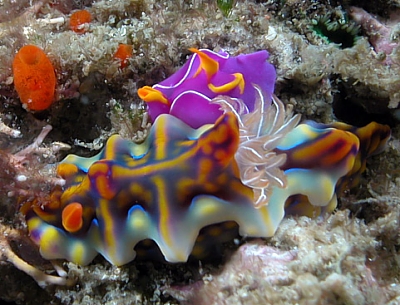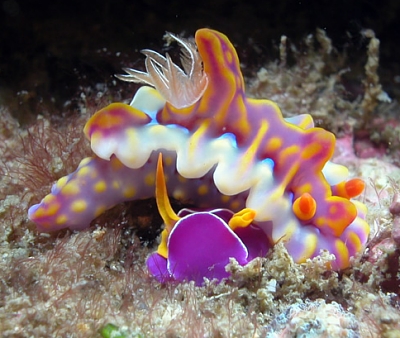Coincidental occurrence of Ceratosoma flavicostatum & S. ornatum
September 6, 2007
From: David Mullins

Dear Bill,
Ceratosoma flavicostatum & Sagaminopteron ornatum
These 2 photos were taken at the same site and depth 3 years apart almost to the day. I was going through my pics and cataloguing them when I noticed that the top photo taken 14 August 2004 was very similar to one I remembered taking 2 weeks ago,18 August 2007, bottom photo.
Putting aside the incredible coincidence of date and place (which I can't)I have a question for you. I don't really expect an answer except to say that they might have similar food preferences and that I dive too often and take too many pics so it was bound to happen.
Locality: S.E. corner, Old Woman Island, Maroochydore,, 10 metres, Queensland, Australia., Pacific Ocean, 14 August 2004 & 18 August 2007, rocky reef. Length: 45 mm & 15 mm. Photographer: David Mullins.
The question is: do you believe there are any interspecific associations in the Opisthobranch world? Given that on both occasions the different species depicted here are seen in exactly the same relative position to each other, one really wonders at first if there is.
I don't know what you can do with this other than put it in the anecdotal file. Enjoy.
Regards,
David Mullins.
david@nudibranch.com.au
Mullins, D.A., 2007 (Sep 6) Coincidental occurrence of Ceratosoma flavicostatum & S. ornatum. [Message in] Sea Slug Forum. Australian Museum, Sydney. Available from http://www.seaslugforum.net/find/20587
Dear David,
I have changed your identification of the Ceratosoma from C. magnificum. Have a look at my message #19854 where I discuss this name and suggest we should identify your animal as C. flavicostatum.
Finding these two species together does seem an amazing coincidence, but there may in fact be a reason for it. Most species of Ceratosoma feed on dysideid sponges, and we have one record [#19277] suggesting it does as well. Many species of gastropterid, including Sagaminopteron ornatum, are often found associated with dysideid sponges, and some authors have suggested they feed on them. I don't agree myself because their teeth and foregut do not appear to be designed for feeding on sponges. I suspect that like species of Trapania, which are also often found on sponges, that they are feeding on some animal which is itself associated with sponges. I know that compared with some of the great unanswered mysteries in the world, knowing what gastropterids eat is not very high in the priority list, but it is one of those nagging mysteries I would love to see answered.
Best wishes,
Bill Rudman
Related messages
-
Re: Ceratosoma flavicostatum feeding
From: Teresa Zuberbühler, June 10, 2008 -
Re: Ceratosoma flavicostatum feeding
From: Leanne & David Atkinson, July 5, 2007 -
Ceratosoma flavicostata feeding
From: Danny Van Belle, April 30, 2007 -
Ceratosoma sinuata from Queensland
From: Gary Cobb, July 14, 2003 -
Sprinting Ceratosoma sinuata
From: Sabine Noack, October 22, 2002 -
Ceratosoma magnifica trailing
From: Ákos Lumnitzer, January 10, 2002 -
Ceratosoma sinuata from Indonesia
From: Ken Knezick , January 16, 2001 -
Re: Left-handed Ceratosoma sinuata
From: Donata P. & Akos L., October 27, 2000 -
Ceratosoma sinuata - magnifica form
From: Akos L. & Donata P, October 25, 2000 -
Ceratosoma sinuata - how long-lived?
From: Donata P. & Akos L., October 19, 2000 -
Miamira from New South Wales
From: Scott Jamieson, April 13, 1999 -
Photo of Miamira at Point Cartwright
From: Wayne Ellis, May 26, 1998
